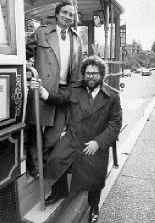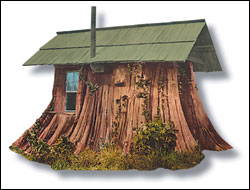THIS IS MY PRE-FAREWELL column. Various press reports in the town’s minor papers were true: I am leaving Seattle Weekly at the end of September to join a start-up called Takingabreak.com.
After 10 years at the Weekly, I’ve decided to de-stress and devote time to writing, in that order. I’m going to take some serious time off (the first since high school) and reincarnate as a cranky regional writer with a fascination for where we come from and where we’re headed. I might also have a new hobby. If the Bush/Dick ticket wins, I may form an armed militia; if Gore/Joe (or is it Marjoe?) wins, it may be the area’s first neo-pagan armed militia; if either Nader or Hagelin wins, I can be found making snowballs in hell. And if Buchanan wins, write me at my new address: Wilkes Land, Antarctica.
STARTING UP A NEW career is not new for me. I’ve done it many times. My first job was at a Silicon Valley magazine start-up in the mid-1970s where I got to interview guys like a then-unknown entrepreneur named Nolan Bushnell who had just invented an amusing game called Pong. I came back to Seattle and joined the start-up of a national magazine, Adventure Travel, which discovered double-income yuppie consumers before the word yuppie was even in common usage. I helped start up a publishing consulting company, Pacific Publishing Associates, where we advised on start-ups. A few years later, I joined the start-up of once successful, now defunct state magazine Washington, which promoted raising the Cascade Curtain to unify both halves of the state. Our most famous cover featured those icons of the go-go ’80s, Bill Gates and the Boz. While there, I helped start up Columbia, the state historical society’s magazine.
After Washington, I was hired by Weekly founder David Brewster to (guess what?) start up a new alternative weekly on the Eastside, Eastsideweek. David hired me for several reasons. One, we knew and respected each other, though we’d never worked together; two, I was the only editor he knew who lived on the Eastside; and three, I was a start-up guy.
I dwell on start-ups because most media these days seem to think dot-com entrepreneurs invented them. I have friends who are out there in the high-tech start-up world being executives and assembling workstations for new employees, and though I’ve never started a tech company, it’s all the same: long hours, blood, toil, tears, and sweat, all for a big payoff—if a million things don’t go wrong.
For me it’s never been money: I could paper a rec room with worthless stock I’ve received. I could paper another, in reasonably large bills, with the wages I’ve deferred or lost. For me, it’s always been the thrill of starting something from nothing—maybe just a phone and a card table—and winding up with a newspaper or magazine that made a difference. It was the thrill of creating something out of words, and little else. At Adventure Travel, I had to hire 20 writers in one week, and they wrote their first pieces sitting on cardboard boxes. At the Silicon Valley magazine, part of my job was to divert bill collectors and process servers while the publisher escaped out the back. At Eastsideweek, we raised our venture capital by the end of August, hired a staff in September, and had papers on the street—a full-blown alternative weekly—by the end of October. If you don’t do that shit for money, you better do it for love.
I have a little start-up in the blood: My paternal grandfather started a successful engineering company here in Seattle. He began in his basement and eventually had a large factory that you can see today, crumbling on Harbor Island near the Fisher Flour towers. “Smith-Berger,” it still says in giant orange letters on the side of the building. He made high-end logging equipment and invented a kind of seagoing winch that helped get landing craft off the beaches in WWII. My maternal grandfather came to Seattle during the previous high-tech boom: He went to the Klondike with a state-of-the-art gold pan in ’98 and brought back a nugget the size of a fist. Otherwise, he worked his tail off for the memories.
WITH NEW OWNERS and the retirement of Seattle Weekly‘s founder, I’ve engineered a reinventing of the paper over the last few years; though to be truthful, a hallmark of David Brewster’s tenure was a continual sense of reinventing the paper. This evolution had moved us in new directions, and I feel less like I’ve accomplished something than helped keep it in motion. I think that’s one of the most appealing things about publishing: The business plan is more solid—and way more profitable—than Amazon’s, but the product itself is a constant improvisation, a melding of old and new that both satisfies and teases the reader’s expectations. The value of a paper is real, but ephemeral: It thrives on the interactions it creates, not the physical newsprint it amasses. Keeping a paper stoked, enlivened, and relevant is a constant task, an uncertain science.
Whoever my successor is—and our sharp new publisher, Alisa Cromer, tells me she will conduct a national search—their task will be to take the reins of real assets (writers, editors, art directors, photographers, a 25-year tradition of great alternative journalism) and whip them into a palpable frenzy to make something relevant out of nothing for readers each week.
Something out of nothing. It’s the ultimate, everyday start-up.







